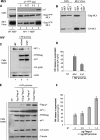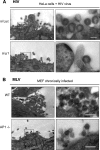The clathrin adaptor complex AP-1 binds HIV-1 and MLV Gag and facilitates their budding
- PMID: 17538020
- PMCID: PMC1949356
- DOI: 10.1091/mbc.e06-12-1147
The clathrin adaptor complex AP-1 binds HIV-1 and MLV Gag and facilitates their budding
Abstract
Retroviral assembly is driven by Gag, and nascent viral particles escape cells by recruiting the machinery that forms intralumenal vesicles of multivesicular bodies. In this study, we show that the clathrin adaptor complex AP-1 is involved in retroviral release. The absence of AP-1mu obtained by genetic knock-out or by RNA interference reduces budding of murine leukemia virus (MLV) and HIV-1, leading to a delay of viral propagation in cell culture. In contrast, overexpression of AP-1mu enhances release of HIV-1 Gag. We show that the AP-1 complex facilitates retroviral budding through a direct interaction between the matrix and AP-1mu. Less MLV Gag is found associated with late endosomes in cells lacking AP-1, and our results suggest that AP-1 and AP-3 could function on the same pathway that leads to Gag release. In addition, we find that AP-1 interacts with Tsg101 and Nedd4.1, two cellular proteins known to be involved in HIV-1 and MLV budding. We propose that AP-1 promotes Gag release by transporting it to intracellular sites of active budding, and/or by facilitating its interactions with other cellular partners.
Figures








Similar articles
-
Defects in human immunodeficiency virus budding and endosomal sorting induced by TSG101 overexpression.J Virol. 2003 Jun;77(11):6507-19. doi: 10.1128/jvi.77.11.6507-6519.2003. J Virol. 2003. PMID: 12743307 Free PMC article.
-
Tsg101 and Alix interact with murine leukemia virus Gag and cooperate with Nedd4 ubiquitin ligases during budding.J Biol Chem. 2005 Jul 22;280(29):27004-12. doi: 10.1074/jbc.M413735200. Epub 2005 May 21. J Biol Chem. 2005. PMID: 15908698
-
Nedd4.1-mediated ubiquitination and subsequent recruitment of Tsg101 ensure HTLV-1 Gag trafficking towards the multivesicular body pathway prior to virus budding.J Cell Sci. 2004 May 1;117(Pt 11):2357-67. doi: 10.1242/jcs.01095. J Cell Sci. 2004. PMID: 15126635
-
[HIV budding and Tsg101].Uirusu. 2005 Dec;55(2):281-6. doi: 10.2222/jsv.55.281. Uirusu. 2005. PMID: 16557014 Review. Japanese.
-
Beyond Tsg101: the role of Alix in 'ESCRTing' HIV-1.Nat Rev Microbiol. 2007 Dec;5(12):912-6. doi: 10.1038/nrmicro1790. Nat Rev Microbiol. 2007. PMID: 17982468 Review.
Cited by
-
Filamin A protein interacts with human immunodeficiency virus type 1 Gag protein and contributes to productive particle assembly.J Biol Chem. 2011 Aug 12;286(32):28498-510. doi: 10.1074/jbc.M111.239053. Epub 2011 Jun 24. J Biol Chem. 2011. PMID: 21705339 Free PMC article.
-
Biochemical and proteomic characterization of retrovirus Gag based microparticles carrying melanoma antigens.Sci Rep. 2016 Jul 11;6:29425. doi: 10.1038/srep29425. Sci Rep. 2016. PMID: 27403717 Free PMC article.
-
Evidence of a role for soluble N-ethylmaleimide-sensitive factor attachment protein receptor (SNARE) machinery in HIV-1 assembly and release.J Biol Chem. 2011 Aug 26;286(34):29861-71. doi: 10.1074/jbc.M111.241521. Epub 2011 Jun 16. J Biol Chem. 2011. PMID: 21680744 Free PMC article.
-
Inhibition of early stages of HIV-1 assembly by INI1/hSNF5 transdominant negative mutant S6.J Virol. 2011 Mar;85(5):2254-65. doi: 10.1128/JVI.00006-10. Epub 2010 Dec 15. J Virol. 2011. PMID: 21159874 Free PMC article.
-
Different Ability of Multidrug-Resistant and -Sensitive Counterpart Cells to Release and Capture Extracellular Vesicles.Cells. 2021 Oct 26;10(11):2886. doi: 10.3390/cells10112886. Cells. 2021. PMID: 34831110 Free PMC article.
References
-
- Babst M., Katzmann D. J., Estepa-Sabal E. J., Meerloo T., Emr S. D. Escrt-III: an endosome-associated heterooligomeric protein complex required for mvb sorting. Dev. Cell. 2002a;3:271–282. - PubMed
-
- Babst M., Katzmann D. J., Snyder W. B., Wendland B., Emr S. D. Endosome-associated complex, ESCRT-II, recruits transport machinery for protein sorting at the multivesicular body. Dev. Cell. 2002b;3:283–289. - PubMed
-
- Basyuk E., Galli T., Mougel M., Blanchard J., Sitbon M., Bertrand E. Retroviral genomic RNAs are transported to the plasma membrane by endosomal vesicles. Dev. Cell. 2003;5:161–174. - PubMed
-
- Batonick M., Favre M., Boge M., Spearman P., Honing S., Thali M. Interaction of HIV-1 Gag with the clathrin-associated adaptor AP-2. Virology. 2005;342:190–200. - PubMed
Publication types
MeSH terms
Substances
LinkOut - more resources
Full Text Sources
Other Literature Sources

